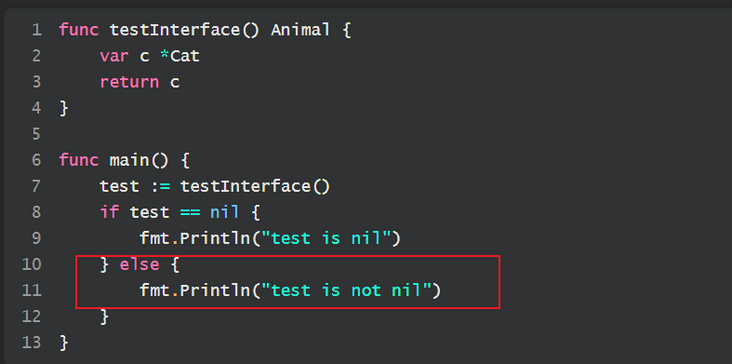这篇“Golang中interface{}的注意事项是什么”文章的知识点大部分人都不太理解,所以小编给大家总结了以下内容,内容详细,步骤清晰,具有一定的借鉴价值,希望大家阅读完这篇文章能有所收获,下面我们一起来看看这篇“Golang中interface{}的注意事项是什么”文章吧。
interface {} 可以用于模拟多态
xdm 咱们写一个简单的例子,就举动物的例子
写一个 Animal 的接口,类似于 java 里面的抽象类 ,Animal 的接口 中有 2 个方案待实现
写一个 Cat 来继承 Animal , 实现 Eat 方法和 Drink 方法
动物都有吃和喝的行为,小猫吃的行为是吃鱼,小猫的喝的行为是喝可乐
最后在主函数中,使用父类的指针,来指向子类的实例化的一个子类地址
type Animal interface { Eat(string) string Drink(string) string}type Cat struct{}func (c *Cat) Eat(food string) string { if food != "fish" { return "i dislike" } else { return "i like" }}func (c *Cat) Drink(drink string) string { if drink == "coke" { return "i love" }else{ return "abandon" }}func main(){ var a Animal = &Cat{} fmt.Println(a.Eat("fish")) fmt.Println(a.Drink("water"))}看到上述代码,会不会有这样的疑问,命名是 &Cat{} 是取地址的,为什么 var a Animal 不写成指针呢?
这里需要注意,Animal 本身是 接口类型,自身就是一个指针
运行上述代码查看效果
# go run main.go
i like
abandon
没有毛病,小猫眯爱吃鱼,不爱喝水
interface{} 需要注意空和非空的情况
什么叫做空的 interface{} , 什么又叫做非空的 interface{} 呢?
咱们还是用上面的例子, 添加一个 testInterface 函数,来实践一下
func testInterface() Animal { var c *Cat return c}func main() { test := testInterface() if test == nil { fmt.Println("test is nil") } else { fmt.Println("test is not nil") }}可以猜猜看,上面这个小案例会输出什么结果
理论上来看,testInterface 函数中我们只是创建了一个 Cat 指针,并没有赋值,因此默认是一个零值,因此会是一个 nil,那么 return 的时候,应该也是 return nil 才对吧,因此按照代码的逻辑来说应该是输出 test is nil
执行上述代码后,查看结果
# go run main.go
test is not nil
看到上面的结果,是不是觉得很奇怪,和自己的预期不一致
没关系,之前的文章我们说到过,觉得一个技术点奇怪,不是我们所期望的效果,原因是我们对其原理不够了解,不够熟悉
现在先来回答一下上面的问题
空接口:意思是没有方法的接口,interface{} 源码中表示为 eface 结构体
非空接口:表示有包含方法的接口 , interface{} 源码中表示为 iface 结构体
暂时先来直接介绍源码中的结构体
iface结构体,非空
type iface struct { tab *itab data unsafe.Pointer}type itab struct { inter *interfacetype _type *_type link *itab hash uint32 // copy of _type.hash. Used for type switches. bad bool // type does not implement interface inhash bool // has this itab been added to hash? unused [2]byte fun [1]uintptr // variable sized}tab
指的是具体的类型信息,是一个 itab 结构,结构中成员如上,这里面包含的都是借口的关键信息,例如 hash 值 ,函数指针,等等,后续详细剖析 interface{} 原理的时候再统一说
data
具体的数据信息
eface结构体
type eface struct { _type *_type data unsafe.Pointer}type _type struct { size uintptr // 表示的是 类型的大小 ptrdata uintptr // 值的是前缀指针的内存大小 hash uint32 // 计算数据的 hash 值 tflag tflag align uint8 // 进行内存对齐的 fieldalign uint8 kind uint8 alg *typeAlg gcdata *byte str nameOff ptrToThis typeOff}_type
类型信息,和上面的 非空接口类似 , 这个_type 类型决定下面的 data 字段如何去解释数据
data
具体的数据信息
看到这里,细心的 xdm 是不是就可以看出来,我们上面写的 Animal 接口,其实是一个非空接口,因为里面有包含方法,所以他的底层是一个 iface 结构体 ,非空接口
那么初始化的一个空指针 c ,实际上是 iface 结构体里面的 data 字段为空而已,数据为空而已,但是 iface 这个结构体自己不是空的,所以上述代码走的逻辑是 test is not nil

这里顺带说一下,golang 中,还有哪些数据结构是和 nil 比较是否为零值,这个点我们也可以看看源码
// nil is a predeclared identifier representing the zero value for a// pointer, channel, func, interface, map, or slice type.var nil Type // Type must be a pointer, channel, func, interface, map, or slice type源码中有说到,可以对 指针,通道,函数,接口,map,切片类型使用 nil
以上就是关于“Golang中interface{}的注意事项是什么”这篇文章的内容,相信大家都有了一定的了解,希望小编分享的内容对大家有帮助,若想了解更多相关的知识内容,请关注编程网行业资讯频道。






